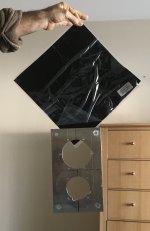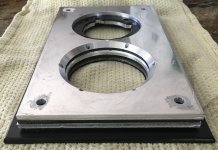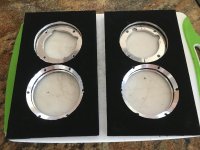It will be interesting how low the 4” in frequency the midbass will go Flat with the cabinet filled to the brim with high density felt. I’m hoping around 200hz. Luckily the cabinet is relatively large compared to the driver’s Vas. That should help me get there.
PEERLESS SLS-P830881(Mid-woofer 4", 8 Ohm, 50 Wmax)
These are the only THD measurements I can find on this driver(I'll also do my own measurements when its all done). Looks pretty outstanding down to around 200hz
These are the only THD measurements I can find on this driver(I'll also do my own measurements when its all done). Looks pretty outstanding down to around 200hz
SCAN SPEAK D2608/913000 (Tweeter 1", 8 Ohm, 80 W)
ScanSpeak D2608/913000 | HiFiCompass
And of course, the venerable and much tested d2608-913000. Look at the thd at 1khz!!
ScanSpeak D2608/913000 | HiFiCompass
And of course, the venerable and much tested d2608-913000. Look at the thd at 1khz!!
Last edited:
How tacky is sorbothane? I put a sheet of it between two of my aluminum baffles to do some experimenting, and it took 15 minutes and all my strength to get them apart. I honestly thought that after trying for 10 minutes that it was possibly going to be permanent. Really strange material.
Last edited:
The leather hole punch kit I have will come in handy for the sorbothane. There is no way that drill bits or screws can get any where near this stuff. Both will grab the sorbothane and rip the hell out of it. Two layers of sorbothane equals 28 holes per baffle. Ugh.
Last edited:
I often make my own leather hole punches by drilling a hole down a bolt ( easy if you've got a lathe handy, not so with woodworking tools I guess, although I'd still try ) then use a bench grinder to give it an edge. I'd guess that sorbothane is so tacky you'd need an exit hole as well, sounds " interesting " to work with.
I just tried the hole punch on some old sorbothane I have of the same thickness and it worked perfectly with no problems. Phew! I could also talc the sorbothane to make it easier to work with and then wash it off(It's waterproof) before the final application.
I'm sure that this strange ability to bond helps sorbothane pull vibrations out of whatever it's attached to.
Are you going to put something between the tweeter and the sorbothane, like paper or aluminium foil so it doesn't get stuck down.
The previous photo is of the back of the baffle, but on the front of the baffle, the tweeter will be mounted directly on to the sorbothane. Getting the tweeter back off the sorbothane(if needed) would Just involve pushing on the motor housing from behind
Putting this much thought, focus and energy into a speaker baffle is somewhat odd compared to how easily and quickly a nice one can be made from wood. Sorry everyone about how long it's taking, but I have one shot at this and I cant screw it up.
It is very interesting...dont rush it! So you chamfered with a normal hss router bit.? How did you do the main round cutouts?
Thank you! Even though I could have used a router/circle jig, I used a drill with metal Hole cutters because I had some of the correct size. If I had to do it again, I would have used the former. It would have made cleaner, CNC looking cuts. The key with the plunge router would obviously be shallower passes compared to doing it with wood.
The chamfer router bit is a simple carbide tipped. Had zero problems. Once again, shallow passes, and 1000 series aluminum alloy group.
Right now I'm trying to think through a few cosmetic issues before final assembly.
The chamfer router bit is a simple carbide tipped. Had zero problems. Once again, shallow passes, and 1000 series aluminum alloy group.
Right now I'm trying to think through a few cosmetic issues before final assembly.
Last edited:
1000 Series has minimum of 99% aluminum with no major alloying additions. These compositions are characterized by excellent corrosion resistance, high thermal and electrical conductivity, low mechanical properties and excellent workability. These alloys are non-heat treatable. The most common type is A91100 which is commercially pure aluminum. It is soft and very ductile, having excellent workability. Well suited for applications involving severe forming as it work hardens more slowly during forming. It is the most weldable of all aluminum alloys.
Baffles are getting too thick, so I’m using 1/16” adhesive neoprene on the back of the baffles. These will essentially act as the gaskets too.
Attachments
Last edited:
The most important thing about sorbothane(not neoprene) is that in order to work best, it needs a certain specific amount of compression. I will tighten a little, knock, tighten a little more and knock again until I get a proper thud.
Compression of the sorbothane will happen at the corners and at the woofer mounts. I wished I could have done the the tweeter area differently but I took the lazy way out and made a larger hole underneath because I didn’t want to deal with more bolt holes and terminal cutouts. That would have given me the opportunity to evenly compress the sorbothane over the entire baffle with just a little more work involved. Oh well.
- Home
- Loudspeakers
- Multi-Way
- Midrange experiment with Auto sound panel deadener and high density acoustic felt..


